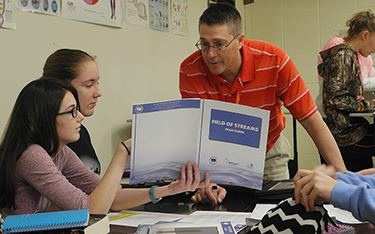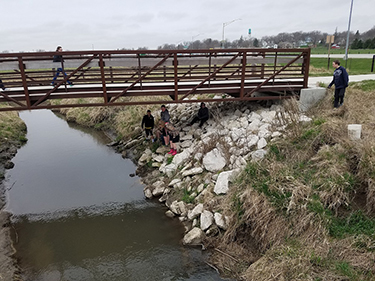
| May 2017 | |||||||||||
| Top stories | |||||||||||
| In the news | |||||||||||
| Photos | |||||||||||
| Contact us | |||||||||||
| Archive | |||||||||||
|
Students ‘extremely engaged’ with lab science |
May 30, 2017 --
Taylor Williams has always felt a connection with nature, but the 13-year-old didn't realize the career options available in science until his rural Iowa school in Manning participated in a program offered through the State Hygienic Laboratory.
 Jim Blankman, science teacher at IKM-Manning, and students discusses the iExplore Laboratory Science project funded through a Telligen Community Initiative Grant.
Jim Blankman, science teacher at IKM-Manning, and students discusses the iExplore Laboratory Science project funded through a Telligen Community Initiative Grant.
The iExplore Laboratory Science project, funded through a Telligen Community Initiative Grant, provided seventh-graders at four Iowa schools with hands-on activities in water quality testing and interactions with laboratory scientists.
"It was pretty fun," said Taylor, who attends IKM-Manning Middle School in west-central Iowa. "I like knowing stuff about where we live and how the environment around us functions."
He and his friends enjoy fishing, which Taylor sees as another connection to a potential career as a marine biologist, or, as he discovered through the program, as a limnologist.
State Hygienic Laboratory limnologists – scientists who study the ecological and environmental health of more than 200 Iowa waterways – interacted with the students via videoconference as part of the project, which the students found particularly beneficial.
"My students were extremely engaged during the lesson," said Erna Mahmutovic, who teaches seventh-grade science at Washington Middle School in Washington, Iowa. "They especially enjoyed reporting their findings to the limnologist at the State Hygienic Lab. I believe this lesson helped spark an interest to pursue science as a career in several students."
Sparking that interest is important for the nation's public health future, said Beth Hochstedler, director of the laboratory’s Office of Education, Training and Professional Development.
 IKM-Manning students prepare to collect water samples from Willow Creek in April as part of the iExplore class project.
IKM-Manning students prepare to collect water samples from Willow Creek in April as part of the iExplore class project.
She cited an assessment conducted by the Association of Schools of Public Health that estimated more than 250,000 additional public health workers will be needed in the United States by 2020 to avoid a major public health crisis.
Hochstedler said grants, such as the one from Telligen Community Initiative – the charitable foundation of Iowa-based Telligen, Inc. – are vital to funding outreach programs to create awareness about careers in public health and to recruit the future workforce.
"Students don't know about the opportunities in our field," she said. "It's up to us to create pathways to promote them."
Erica Larson, Laboratory Education manager and project lead, said the goal of the iExplore project is to increase student understanding of STEM (science, technology, engineering and math) and encourage them to explore careers in laboratory science.
"It's very much a mission of the State Hygienic Laboratory and labs across the country to address this gap," she said of the forecasted worker shortfall.
Rebekah Domayer, Education Outreach support staff, developed the lesson plan with input from the limnologists and provided on-site support at two of the schools.
Domayer said the project offered a trial run in distance-learning technology.
"This is something that hasn't been done here before," she said.
Teachers at the four schools were provided with a teacher’s guide that included a “Field of Streams” lesson plan and field guide, as well as a PowerPoint presentation, activity cards, water test kits, lab record sheets and specimens of six different aquatic organisms.
The students were given a role-playing activity with scenarios of what a limnologist would do in the field, and group activities to present evidence to back up their claims about water quality. Two of the schools took the next step to conduct tests on nearby waterways.
Students reported their results to the limnologists, as well as giving reports on aquatic organisms, such as the invasive zebra mussel, and native species, including the red shiner minnow.
Adam Hietbrink, who teaches seventh- and eighth-grade science at Red Oak Middle School, said the iExplore project showed students how to work with others to solve problems, come up with solutions, and make predictions of possible causes and effects that human interactions can have on the environment and bodies of water.
"Each student had a certain role within the group and everyone had to work collaboratively and listen and evaluate each other’s answers before coming up with a possible solution," he said.
Hietbrink used the project to inform the students' own water quality testing of Red Oak Creek.
The project gave them background information on water temperatures for different organisms' reproduction and survival in a body of water, he said, and also helped students understand turbidity of water and the importance of water quality on microorganisms.
"Not only can chemical tests show healthy water, but having certain microorganisms in a body of water can help a person determine the health of a body of water," Hietbrink said, adding that he will continue to use the project as a part of his water quality curriculum and recommends other teachers try it, as well.
Jim Blankman, who teaches Taylor Williams and other fifth- through eighth-graders at IKM-Manning Middle School, guided students in the iExplore project to simulate lab testing to measure dissolved oxygen, temperature, sediment concentration and pH levels in the water.
"I'm super excited to be involved in anything that brings real life into the classroom," he said.
Jan Rutt, who teaches sixth- to eighth-grade science at Columbus Middle School in Columbus Junction, said her students enjoyed the hands-on project, and one, particularly, who is interested in a career in the Department of Nature Resources, saw a connection between the project and his career goals.
"I think that anything we can do to spark an interest in a student is worth it," Rutt said.